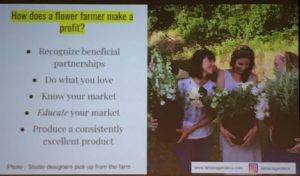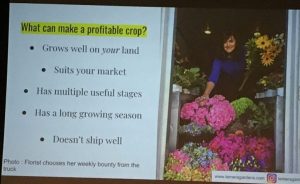This past Saturday (Feb 24), I was given the opportunity to attend Oregon State University’s Small Farm’s Conference. This is an annual conference that is geared toward small farms (30 acres or less) located in the Pacific NorthWest. It is an eclectic mix of vegetable growers, orchardists, ranchers of all sorts of livestock, and cut-flower farmers, with courses geared to any and all of those topics, as well as things like no-till, business/finance planning, farm layout, biodyanic farming, farm policy, and much more. And because my program this quarter is an SOS, the way I get credit is based upon hours (40 hours/week for 10 weeks is the equivalent of 16 credits). Because of this, I am able to count the time spent at this conference toward my SOS.
WELCOME SESSION
Saturday morning started out early at 7:30AM in Corvallis, OR with some breakfast and some networking. As a lot of the sessions overlapped and all looked really interesting and relevant (and because the conference was only $50 total), I forced my partner Tony to attend with me so we could collectively attend more of the breakout sessions and thus gain more of the knowledge. It was definitely good he came not only because of all of the sessions he attended but also because he was able to my future bosses Denis and Diane of Jello Mold. They were there because Diane was giving a talk during the Cash Flow session on crop insurance (which Tony attended). It was good to chat with them and have them meet Tony.
The official welcome session started at 8:50AM with a recognition that the conference was totally sold out, all 1000 seats filled. I also liked that they addressed why the conference cost was so low. As most attendees are just starting out with farming and considered “socially disadvantaged” or “low income,” the organizers of the conference put most of the cost on the sponsors. They really don’t want to gouge those that are just starting out on their journey or are actively working on the slow, local, sustainable food movement.
The keynote speaker of the welcome session was Javier Zamora of JSM Organics located in Aromas, CA. Originally from Mexico, Zamora started with an acre and a half in 2012 but now has 120 acres of fruits/vegetables and 200+ acres of pastureland for cattle. My biggest take-away was that, to be successful you have to diversify and you can’t do it alone. He really stressed having a really solid crew that works well together is derived from paying people what they are worth ($13-$19/hour). To do this, he said he must educate his customers so they know why his produce is priced the way is it and the real cost of their food. He talked about sustainability and how businesses must be economically sustainable as well as environmentally sustainable.
SESSION ONE
Session One, I attended the “Profitable Flowers of the PNW” course. This highlighted three farms in Washington state and Oregon and went into depth about specific crop planning, successful crops for each farm, and avenues of revenue (how they sell their flowers). The three farms speaking were My Garden Overfloweth (Paterson, WA), Le Mera Gardens (Talent, OR), and Field to Heart (Snohomish, WA). Each farm was totally different than the next both in terms of what they were growing (i.e. lisianthus, sunflowers, chrysanthemums, eucalyptus, etc.) and what they were doing with what they grew (i.e. weddings, wholesale, U-Cut, direct to florists, on-site parties, farmers markets, etc.). It was really great to see all these different models of flower farms into successful businesses for them.

From Le Mera Gardens Slide 1/2)

From Le Mera Gardens Slide 2/2)
Tony attended the “Pack Shed Layout” course for Session One. This was lead by Josh Volk (of Slow Hand Farm, a farm we actually visited on a field trip in the Practices of Organic Farming program this past summer). It was all about how to set up your pack shed (where you process your vegetables, fruit, or flowers) to enhance efficiency.
SESSION TWO
For session two, I attended the “Marketing & Selling Specialty Cut Flowers” course. This showcased two farms that have two very different but successful marketing strategies. The first, Bindweed Farm, is located in Blackfoot, ID, right in the middle of Sun Valley, ID and Jackson Hole, WY. The really unique thing about their location and market is that, as they are in the desert there really isn’t anyone else growing flowers in their area but these two towns have a lot of high-end resorts and vacation destinations. Because of this, they sell almost exclusively directly to florists, primarily for destination weddings and weekly resort floral arrangements and focus on varieties that don’t ship very well. The other farm, Whipstone Farm, located in Paulden, AZ, has 3 acres of flowers on their larger 18 acre vegetable farm. They sell mixed bouquets at local farmers markets as well as a bouquet add-on to their CSA (Community Supported Agriculture, where customers pay in at the beginning of the season and receive boxes of produce for a period of time) and focus on flashy and bright pops of color.
Tony attended the “Cash Flow” course. In this, an OSU professor talked about how to map cash flow throughout the season to ensure specific crops are profitable for your small farm and that you end up with something in the bank at the end of the season to be able to do it all over again the next season. At the end, Diane talked about the new USDA’s crop insurance program for specialty crops to further ensure profitability to a small farm even in the face of total crop failure. As someone who hates business planning but knows its essential to a small farm business, these types of courses are so beneficial and it’s really nice to have an actual farmer (Diane) break down what she does to ensure cash flow for her on Jello Mold.
SESSION THREE
I ended with “Accessing & Preserving Farmland” course for Session Three. This session was predominantly about land trusts and conservation easements. The speakers were from two different land trusts, Greenbelt Land Trust (based in the lower Willamette River Valley) and PCC Land Trust (based in the Puget Sound area). A conservation easement basically is a stipulation on the land that limits some of the rights of the land owner (i.e. development rights, subdividing the lot, buffer zones, habitat restoration, etc.) to ensure the land remains agricultural land. While this lowers the value of the land, that difference is paid for by a land trust (generally a non-profit or governmental entity). Conservation easements allow young farmers to access land because it makes the cost of purchasing land a lot lower. According to statistics PCC Land Trust shared with us, “in the last 4 years, the average price per acre of Washington farmland has increased by 47%, 71% of retiring farmers have not identified a successor, and some Washington counties have lost over 70% of its farmland since 1950.” Thus conservation easements allow young farmers to access land that would otherwise go to developers or be sub-divided.

What is a Conservation Easement?, from OSU Small Farms Conference
Tony went to the “Get Legit: Financials for a Small Farm” course for Session Three where they went over how to finance a farm and tax structures based on how you set your business up.
All in all, the OSU Small Farms Conference was a really awesome experience and I got a lot out of it (especially because I was able to get double the courses out of it with Tony going to three extra sessions for me). There was also a killer lunch meal entirely sourced from farms around the PNW that was pretty much worth the $50 fee in and of itself. I’m really glad Evergreen’s education model and SOS’s allow for students to get outside of the classrooms and learn from experts in their fields.


Leave a Reply